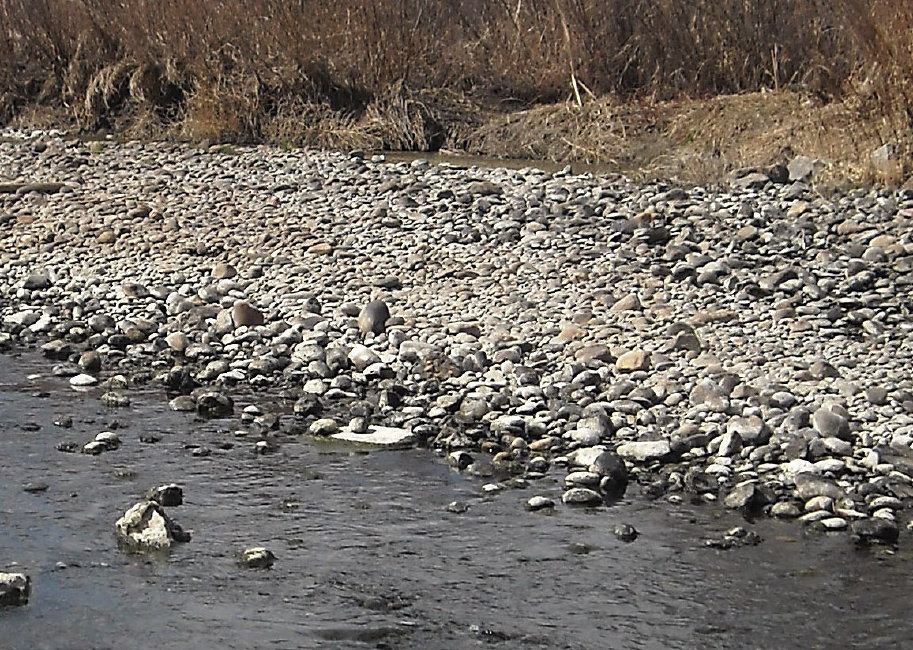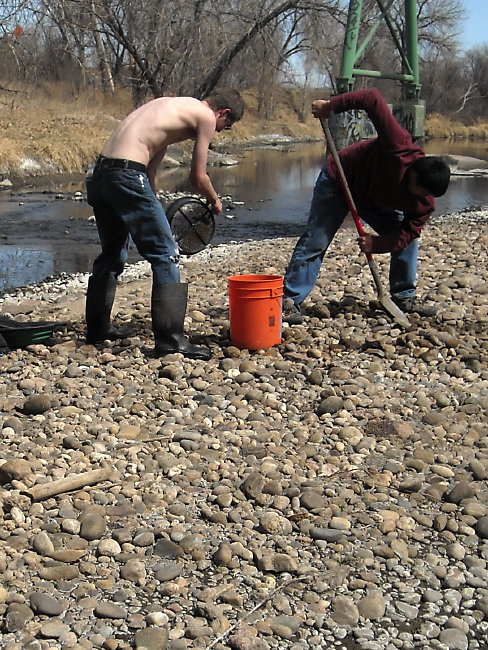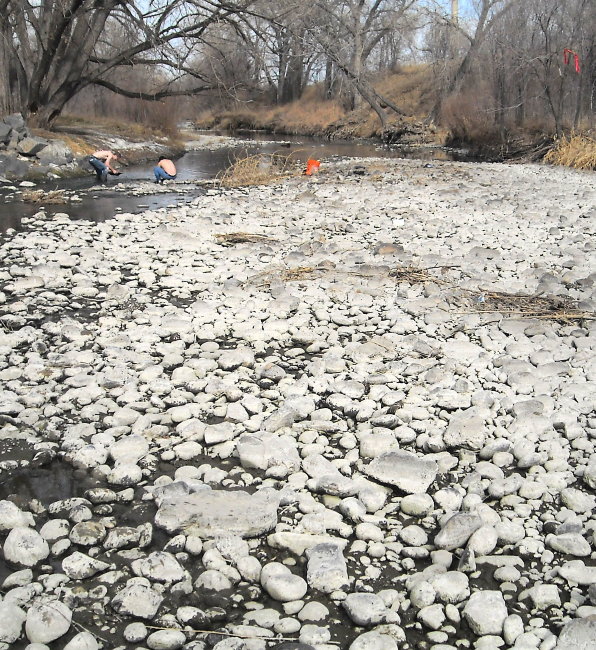Howdy Folks! It has been too long since I've written an article about one of my prospecting adventures. Sometimes life is a busy place. Last month, I completed my last class in an MBA/GM degree program from the University of Phoenix and I have cabin fever (study, study, study) as well as gold fever. With global warming adding to the sunny warm days in March and the low water levels makes this month a good time to do some prospecting before the spring run-off. It is St. Patrick's Day and I feel the luck of the Irish in my blood, and we all know gold prospecting is a bit about luck.
My son Scott and his friend Matt Morales and I grabbed our gold pans, shovels, #4 mesh classifiers, buckets, and sniffer bottles. I first learned to pan for gold in 1982, on Clear Creek, just below Tymkovich Meats, on 70th Avenue and Washington Street. In 1996, I shared that location with the club and we held several panning and sluicing workshops there.
For many years that site was a sure thing. Every year the spring run-off would mobilize particles of gold (flood gold) from up stream and replenish the site with a new placer deposit. Now, the river channel has changed due to the many construction projects and the flood gold is being deposited elsewhere.
The placer deposit that we worked 10 to 27 years ago is now covered with 12" to 16" of over-burden. The only visible gravel bar is directly across the river, see Photo 1 of Gravel Bar #1. Sadly to report, out of two sample pans we only found one find of gold. Back in the days, 1982 to 1999, six to ten or more finds per pan were found, so we will have to look elsewhere for that big pot of gold.

Photo 1
Gravel Bar #1
North side of Clear Creek
below Tymkovich Meats.
Of course the most important piece of prospecting equipment is the gold pan. Before I process any material I first need to find out how much gold is in the host material, quantitatively. To do this, I put the same amount of material in my gold pan each time I sample a site. I pan down the sample the same way each time, and then I count the number of gold finds on the bottom of the pan. Table 1 is my personal guide.
| Go somewhere else! | |
| Put on the to-do-list | |
| Drop everything and DIG! |
To dig or not to dig?
Today is St. Patrick's Day and we are going to spend the day trying to locate new depositional sites (gold bearing gravel bars, a.k.a. placer deposits) and the associated pay streaks using our gold pans as quantitative geologic tools. Oops, there I go with those $100 words.
With no luck below Tymkovich Meats, we moved down river. Just on the other side of Washington St. (east side) and on the south side of the river we found our second gravel bar and our first placer deposit. This skim bar is about 30' by 20' wide, See Photo 2. This site is best accessed by simply walking underneath the Washington St. Bridge along the river's edge.

Photo 2
Gravel Bar #2
Scott and Matt taking a sample
on the highest point on the gravel bar.
We panned a sample from the high point of the gravel bar and found 12 finds. We took another sample half way between the high point and the water's edge and found 9 finds. It looks like the second gravel bar's flood gold is concentrated in the center, length wise. We packed up our stuff and headed down stream.
Three small dams have been constructed to control the water flow since 1999, so for the next 1/2 mile there were no more gravel bars, which was very disappointing. After the last dam, there was a decent size gravel bar right in the middle of the river. Our third gravel bar is about 18' wide and 24' long, See Photo 3.
Wow, 20 some finds of gold off the first few inches of gravel. Someone else had been there once before with a sluice box and had dug a hole 2' wide by 1' deep, so we made use of the existing hole and took a sample from the bottom and we only found 1 gold find. The previous prospector dug right through the pay streak. One has to remember the gold is deposited in layers and sometimes that layer is not very thick, only a few inches, so down is not always the answer. The pay streak is only from the surface to about 4" deep and it is spread across gravel bar 3.

Photo 3
Gravel Bar #3
Matt is classifying material for a sample
and Scott is panning a different sample
from another spot closer to the water.
Our enthusiasm had greatly increased at this site and we were ready to call this a keeper, but we had more time, so we moved further down stream to the next gravel bar, See Photo 4.
We took some samples 3" to 4" deep toward the tail of this skim bar at 3' and 8' from the river's edge. Scott found 43 finds of gold and Matt found 40.

Photo 4
Gravel Bar #4
This is one large gravel bar,
about 30 wide by 150 long.
Scott and Matt are panning in upper left.
For me, that is off the record books. I took a test pan from where Scott took his, but I went down 8 inches, which was at the water table, and I found 38 finds of gold in one pan, Photo 5. All three of us were amazed to find so many finds in one pan. We felt like we'd hit the mother lode!

Photo 5
Steven Cychosz panning,
and dog Aspen.
We found our pot of gold and decided we would come back on Thursday with our sluice boxes and move some pay dirt.
Strangely enough, this site is about 300' east from where I taught a high-banking and dredging workshop for the club in 1996. The river is completely different now with the addition of the interstate interchanges. The caissons and retaining walls for the interstate have removed that site and narrowed the river channel. The narrow river channel causes the water's velocity to increase thus suspending and transporting gold and gravel downstream. The river then widens and the velocity of the water decreases causing deposition. I think the leprechaun gave up some of his gold on this St. Patrick's Day 2009.
I founded this club so like minded people could meet and share their prospecting experiences, so all could learn and grow from those experiences. To continue that tradition you can locate my St. Patrick's Day placer deposits just off of 70th Avenue. From I-25 go east on 70th Avenue past Washington Street for about 1/2 mile and you will find a dirt parking lot on the south side of 70th Street. The parking lot is between Washington Street and York Street. The parking lot is maintained by Adams County and it provides access to the bike path along Clear Creek.
Go to the east end of the parking lot and you will see an access gate to the bike path in the south-east corner. Go through the gate, cross the bike path, and walk down the dirt trail to the river and you will see a huge placer deposit, Gravel Bar 4, on the other side of the river. The river is only four to ten inches deep with just enough velocity to run some sluice boxes with ease.
Gravel Bar 3 is best accessed from the other end of the parking lot in the south-west corner. Walk toward the river and you won't miss it.
Enjoy, and may your pan always over-flow with gold.
Goldman Steve